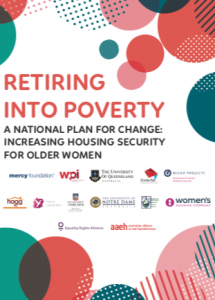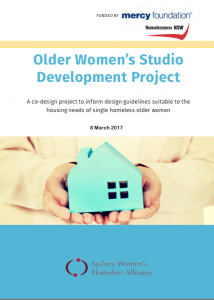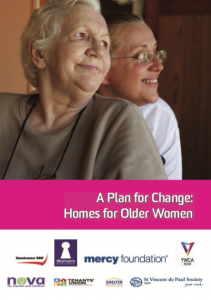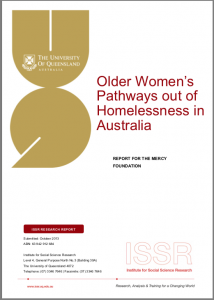Everyone needs a safe and secure home, where we can live close to family and friends, especially as we grow older. It’s shameful that many older women are now facing an insecure future of homelessness and housing instability. There are solutions to this troubling and unjust issue and we are working with Ageing on the Edge NSW to address the drivers of homelessness for older women.
The 2016 Census showed that older women were the fastest growing group to experience homelessness in Australia. The number of women over 55 experiencing homelessness increased by 31% to 6,866, compared to 2011. The 2021 Census reported an increase of 6.6% to 7,325 women over 55 experiencing homelessness.
These are alarming statistics. According to the 2021 Census, the total number of people experiencing homelessness in Australia grew by 5.2% to 122,494.
Research shows that most women experiencing homelessness have never been homeless before. This person could be your sister, aunt, mother or grandmother.
Where are they?
Many women move between staying with children, relatives or friends to keep a roof over their head. Some are adept at house-sitting whilst others sleep in their car when there is nowhere else to go.
Why are women over 55 years at risk of homelessness?
Women over 55 are at great risk of financial and housing insecurity due to systemic and compounding factors such as:
- Lack of superannuation
- Working part time or casually throughout their lives
- Taking time out of the workforce to care for family
- Bearing the brunt of the gender pay gap
- An increasingly unaffordable private rental market
- Age discrimination
This group of women have suffered lifelong discrimination. Some were forced to resign when they married or were pregnant; financial discrimination meant that many were unable to enter into a home mortgage until the 1970’s; age discrimination means that older people find it difficult to find employment.
A life event such as the death of a spouse, serious illness, divorce or no-grounds eviction can push a woman into homelessness.
Women living on a low, fixed income, who have not had the opportunity to buy a home are at great risk of homelessness.
Research shows that most older women who are homeless have never been homeless before. In fact, many don’t self-identify as experiencing homelessness, as they view homelessness as the stereotypical image of a man sleeping rough.
Most women blame themselves for their homelessness. The reality is, no matter what they might have done, their homelessness is not their fault. The blame lies squarely on a broken system.
Women should not be living with the fear of homelessness at this point of their lives.
An increasing issue?
One statistics that is worrying many is that the number of older women in the private rental market doubled from 90,000 in 2006 to over 180,000 in 2016. Some describe this as a tsunami of older women on the verge of experiencing homelessness.
A report released in August 2020 by HAAG and Social Ventures Australia finds that the number of older women at risk of homelessness in Australia is a staggering 405,000. This includes:
- 165,000 women aged between 45 – 55 years and
- 240,000 women aged 55 years and over.
Root cause: Poverty
The root cause of all homelessness is poverty. Older women are more likely to be living in poverty than older men due to a lifetime of discrimination that included unpaid or paid work.
Lack of specialist services
Of the 1,518 homelessness services agencies across Australia, only 3 are funded as specialist services for older people. Expansion of the Home at Last service by HAAG in Victoria would deliver a specialist service that focus on the needs of older people facing homelessness. Home at Last is a successful service providing this invaluable support to older people in Victoria.
Rental (un)affordability
The latest Rental Affordability Snapshot by Anglicare shows that only 0.5% or 386 of the 74,000 properties available for rent across Australia were affordable for a single person on the Age Pension.
The Solution? Affordable, appropriate, safe, permanent housing
Women experiencing homelessness need appropriate, long term, affordable housing. Stable housing is important for good health and well being. Housing is an important health intervention. Women’s health needs generally increase as they age and can be exacerbated by insecure housing or homelessness.
Older women generally have low needs and need nothing more than a safe, affordable, permanent home.
Recommendations
The National Older Women’s Housing and Homelessness Working Group identified the following actions to address this issue. The complete recommendations can be found in the report.
- Develop a National Housing and Homelessness Strategy with specific targets for women and older women
- Implement a Federal Government Strategy to address the current financial insecurity of older women.
- Special measures are needed to assist women currently at retirement age who have not accumulated superannuation due to lower life earnings. Gender inequality and discrimination must be addressed.
- Prevent future generations from risking homelessness by developing a comprehensive Federal Government Strategy to address the underlying causes of gender inequality.
- Establish a Seniors Hosting Gateway Program to address the housing support needs of vulnerable older women.
- Ensure the national aged care policy addresses housing adequacy.
Source: Retiring into poverty – A national plan for change: Increasing the housing security for older women
Research reports:





